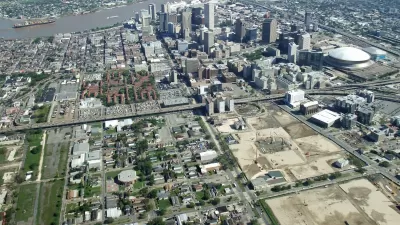Ten years ago, a number of architecture firms went to New Orleans in the wake of Hurricane Katrina for a humanitarian "experiment"—rebuilding part of the underserved Lower Ninth Ward as an innovative, LEED Platinum, affordable community.
Today, tour buses regularly visit the hundred or so cheerfully colored, creatively shaped houses designed by high-profile architects like Frank Gehry and Thom Mayne—where residents may pay as little as $25 a month for utilities.
The "starchitects" were invited by Brad Pitt’s Make It Right Foundation. So was community planning and design firm Concordia, which also coordinated the New Orleans' "People's Plan"—a recovery plan grounded in input from the residents of the vulnerable and long-neglected Lower Ninth Ward.
"The people in the trenches were the heroes," according to Concordia founder Steven Bingler. "They stepped up—literally out of four or eight feet of water, or off of a rooftop—then picked themselves up and got engaged in the recovery."
Two previous attempts at recovery plans sparked suspicion of racial bias and fear that communities of color in the Lower Ninth would be wiped out altogether. Finally, the Greater New Orleans Foundation and the Rockefeller Foundation partnered with Concordia, which undertook an extensive citizen engagement process to revive—not replace—the community.
Bingler remembers a crowded Convention Center, where two-way broadcast connections and classroom clickers enabled people who had fled as far as Atlanta to participate in the planning process for their home neighborhoods.
Martin Pedersen, a longtime architecture journalist, notes that this commitment to inclusion is rare in the field. "Architects’ idea of community engagement is to first think of a design and then sell it to an oftentimes-reluctant public. That’s called 'bringing them around.' But really, is that any different from what a used-car salesman does?" he says.
For Pedersen, New Orleans is proof that "authentic" community engagement can transform whole cities. He tells The Planning Report:
"What was amazing about the post-Katrina experience—watching it from afar—was that the city didn’t have a huge civic infrastructure of democratic involvement. They had to grow it on the fly… The neighborhoods that came back the strongest are the ones that organized and participated fully. The ones that didn’t were often spread out and without a voice."
Much has been accomplished in New Orleans since the storm, but the city still has a good deal of recovering to do—as well as preparation for future weather events. Looking back on what occurred 10 years ago, Bingler issues a warning to other cities to look forward, too: "We’re going to have to apply our hard-earned experience in a lot of other places in the next 40–60 years."
Bingler and Pedersen are co-authoring the forthcoming book Building on the Common Edge. Read their full joint interview in The Planning Report.
FULL STORY: Katrina + 10: It's Engaged Citizens Who Saved New Orleans

Planetizen Federal Action Tracker
A weekly monitor of how Trump’s orders and actions are impacting planners and planning in America.

Map: Where Senate Republicans Want to Sell Your Public Lands
For public land advocates, the Senate Republicans’ proposal to sell millions of acres of public land in the West is “the biggest fight of their careers.”

Restaurant Patios Were a Pandemic Win — Why Were They so Hard to Keep?
Social distancing requirements and changes in travel patterns prompted cities to pilot new uses for street and sidewalk space. Then it got complicated.

California Homeless Arrests, Citations Spike After Ruling
An investigation reveals that anti-homeless actions increased up to 500% after Grants Pass v. Johnson — even in cities claiming no policy change.

Albuquerque Route 66 Motels Become Affordable Housing
A $4 million city fund is incentivizing developers to breathe new life into derelict midcentury motels.

DC Area County Eliminates Bus Fares
Montgomery County joins a growing trend of making transit free.
Urban Design for Planners 1: Software Tools
This six-course series explores essential urban design concepts using open source software and equips planners with the tools they need to participate fully in the urban design process.
Planning for Universal Design
Learn the tools for implementing Universal Design in planning regulations.
Heyer Gruel & Associates PA
JM Goldson LLC
Custer County Colorado
City of Camden Redevelopment Agency
City of Astoria
Transportation Research & Education Center (TREC) at Portland State University
Camden Redevelopment Agency
City of Claremont
Municipality of Princeton (NJ)




























